Let The Tropical Botanical Tour Begin (Page Two)
Today we get to behind the scenes with Dylan Hannon, The Huntington's curator of tropical collections, for a tour of the botanical nurseries where rare orchids and other plants are grown. The tour begins after a spot of tea in the Rose Team Room.... and a walk though the Japanese and Chinese Gardens!
Did You Know? - Dylan was raised in Southern California, where he developed an early interest in a wide range of plant groups. Both his mother and grandmother helped nurture an avid appreciation of plants. He has worked for over 25 years in the botanical garden field, starting as a research assistant to Dr. Thomas B. Croat at Missouri Botanical Garden, working on the taxonomy of Araceae (aroids).
He spent nine years as Plant Propagator at Rancho Santa Ana Botanic Garden in Claremont, CA, and has been Curator of Conservatory Collections at The Huntington Botanical Gardens since 2003. In between these posts Dylan worked in the wholesale cactus industry and for consulting firms as a field botanist in the San Diego area.
His main interest is the propagation and distribution of cultivated plants, particularly material of known wild origin. These themes run through Dylan's writing, lectures, plant collecting and a mail order business ("dylansbulbs" on eBay). He is blessed to have his supportive wife Antoinette by his side.
Dylan has worked for over 20 years in the botanical garden field, starting as a research assistant to Dr. Thomas B. Croat at Missouri Botanical Garden. He spent nine years at Rancho Santa Ana Botanic Garden as Plant Propagator and has been Curator of Conservatory and Tropical Collections at The Huntington since 2003.
In between these posts Dylan worked in the wholesale cactus business and for several consulting firms as a field botanist in San DiegoCounty. Currently he maintains a collection of mainly geophytic plants and keeps busy with a developing mail order business, writing, photography and lectures.
His main interest is the propagation and distribution of cultivated plants, particularly material of known wild origin. These themes run through Dylan's writing, lectures, plant collecting and a mail order business ("dylansbulbs" on eBay).

We have arrived but the tour took off without us....
After a mad dash, we caught up!

Did You Know? - A greenhouse (also called a glasshouse) is a building in which plants are grown. These structures range in size from small sheds to industrial-sized buildings. A miniature greenhouse is known as a cold frame.
Commercial glass greenhouses are often high tech production facilities for vegetables or flowers. The glass greenhouses are filled with equipment like screening installations, heating, cooling, lighting and may be automatically controlled by a computer.
A greenhouse is a structural building with different types of covering materials, such as a glass or plastic roof and frequently glass or plastic walls; it heats up because incoming visible sunshine is absorbed inside the structure. Air warmed by the heat from warmed interior surfaces is retained in the building by the roof and wall; the air that is warmed near the ground is prevented from rising indefinitely and flowing away. This is not the same mechanism as the "greenhouse effect".

The first "hot house" was indeed just that... in the 80's with 90% humidity...
The flowers loved it!

Just amazing... Will we ever know why Mother Nature created this flower

She had something in mind probably for it's survival in the jungles


The plants were well numbered but we could not figure out the placement except
the ones needing more light were in the south-end of the building

We had amplifiers so we could hear every work from the tour guide...
He was the Botanist
Did You Know? - Botany, also called plant science(s) or plant biology, is the science of plant life and a branch of biology. A botanist is a scientist who specializes in this field of study. The term "botany" comes from the Ancient Greek word ?????? (botane) meaning "pasture", "grass", or "fodder"; ?????? is in turn derived from ??????? (boskein), "to feed" or "to graze".
A person who studies plants may be called a botanist or a plant scientist. Traditionally, botany has included the study of fungi and algae, studied by mycologists, phycologists respectively, with the study of plants and these three groups of organisms remain within the sphere of interest of the International Botanical Congress.
Nowadays, botanists study approximately 400,000 species of living organisms of which some 260,000 species are vascular plants and about 248,000 are flowering plants.
Botany originated in prehistory as herbalism with the efforts of early humans to identify ? and later cultivate ? edible, medicinal and poisonous plants, making it one of the oldest branches of science.
Medieval physic gardens, often attached to monasteries, contained plants of medical importance. They were forerunners of the first botanical gardens attached to universities, founded from the 1540s onwards. One of the earliest was the Padua botanical garden.
These gardens facilitated the academic study of plants. Efforts to catalogue and describe their collections were the beginnings of plant taxonomy, and led in 1753 to the binomial system of Carl Linnaeus that remains in use to this day.
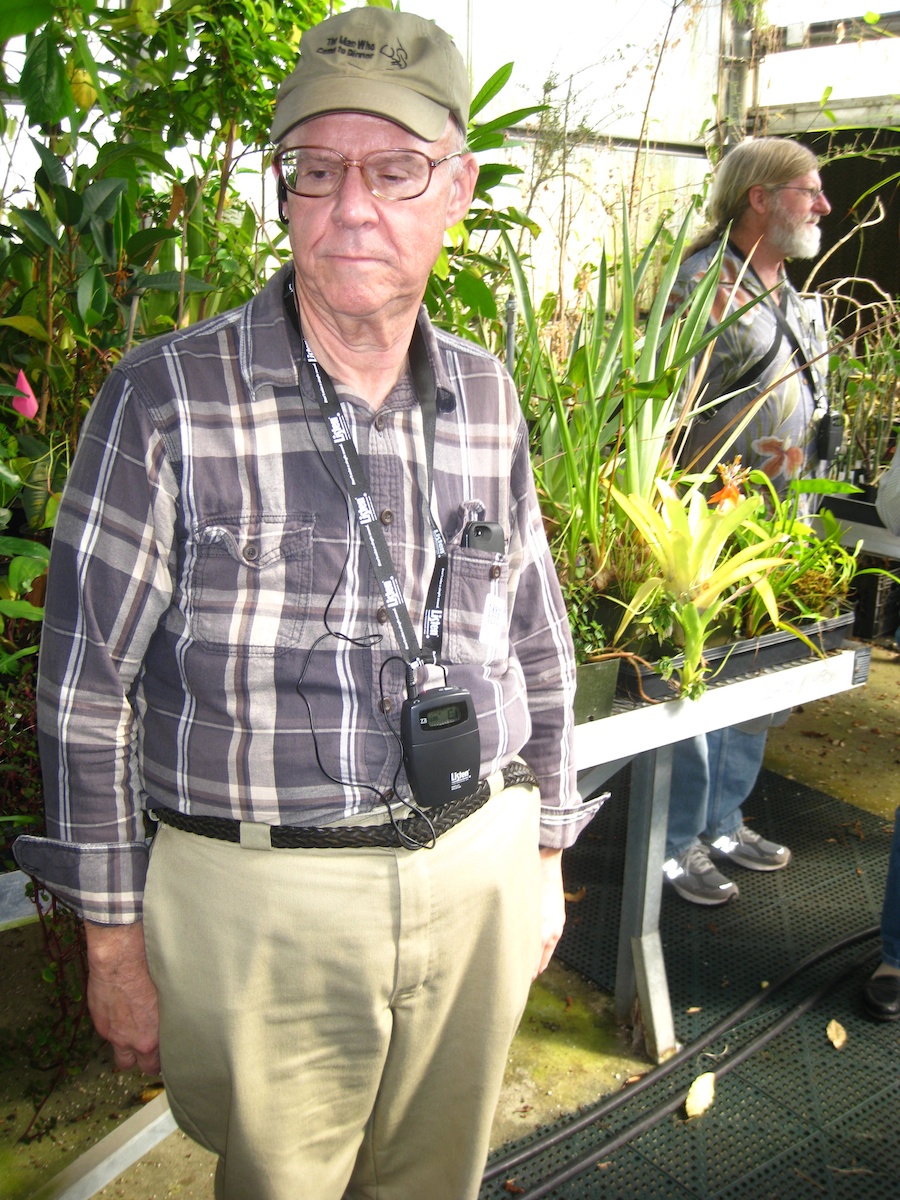
The Birthday Boy is wired!
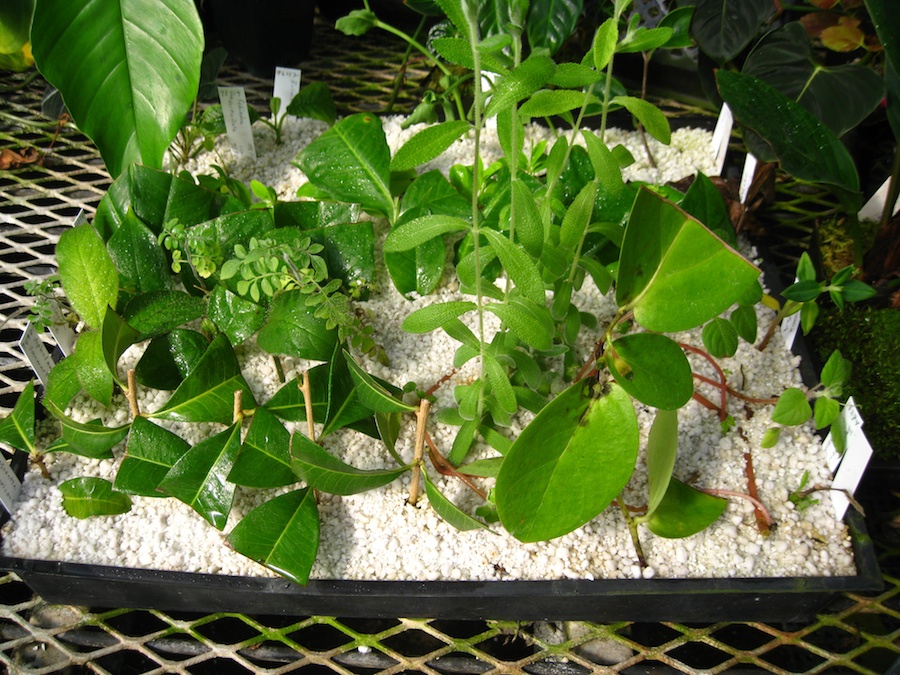
Note the leaves cut in half....
Did You Know? - Leaf cuttings, in which a leaf is placed on moist soil. These have to develop both new stems and new roots. Some leaves will produce one plant at the base of the leaf. In some species, multiple new plants can be produced at many places on one leaf, and these can be induced by cutting the leaf veins.

Magnificent greens
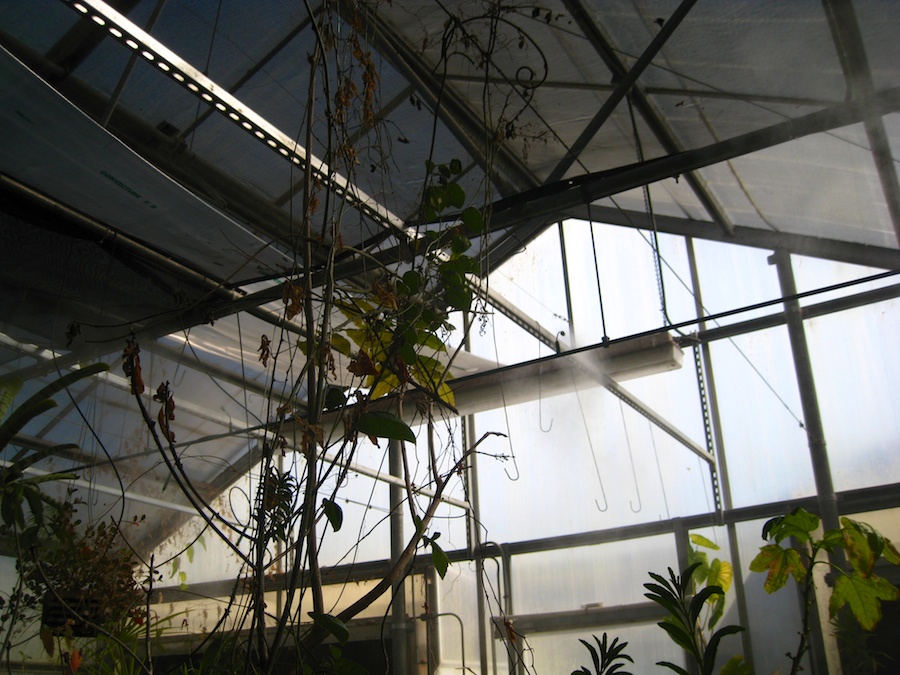
The foggers came on about every 7-10 minutes and raised the humidity
substantially
Did You Know? - Mist is a phenomenon caused by small droplets of water suspended in air. It can occur as part of natural weather or volcanic activity, and is common in cold air above warmer water, in exhaled air in the cold, and in a steam room of a sauna. It can also be created artificially with aerosol canisters if the humidity conditions are right.
The only difference between mist and fog is visibility. This phenomenon is called fog if the visibility is one kilometre (1,100 yards) or less (in the UK for driving purposes the definition of fog is visibility less than 200 metres, for pilots the distance is 1 kilometre).

Lots of hardware in the upper areas...
Misters, heaters, lights, and sensors
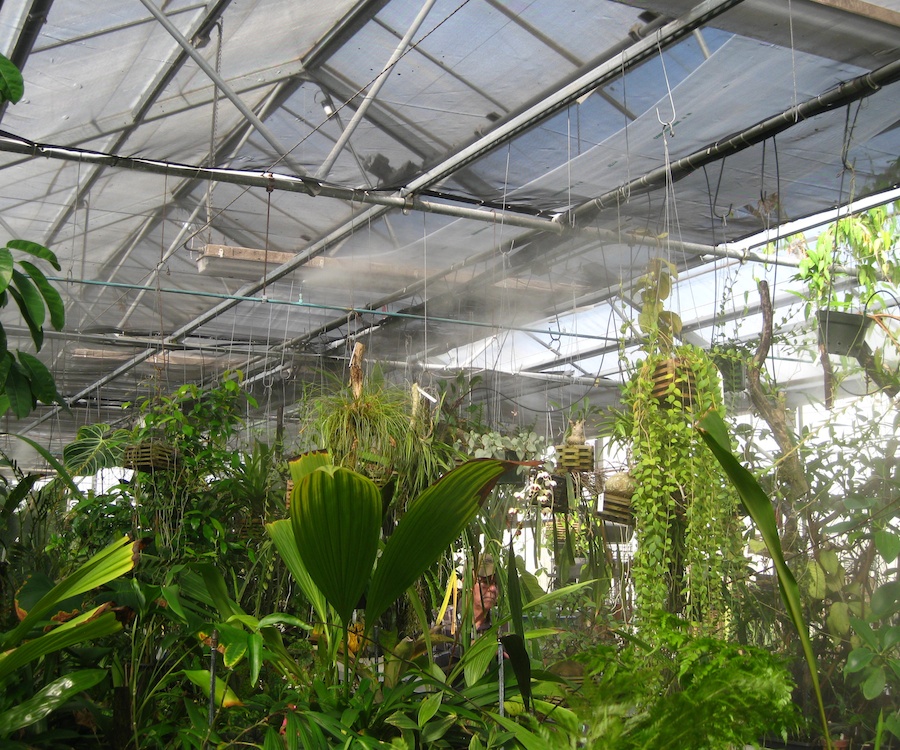
It felt pretty good... Like a nice hot shower

The mist shot out about 15 feet and went on for 10-15 seconds

The Botanist told us the fuzzy plants are probably that way
so they can gather more light (i.e. more surface area)
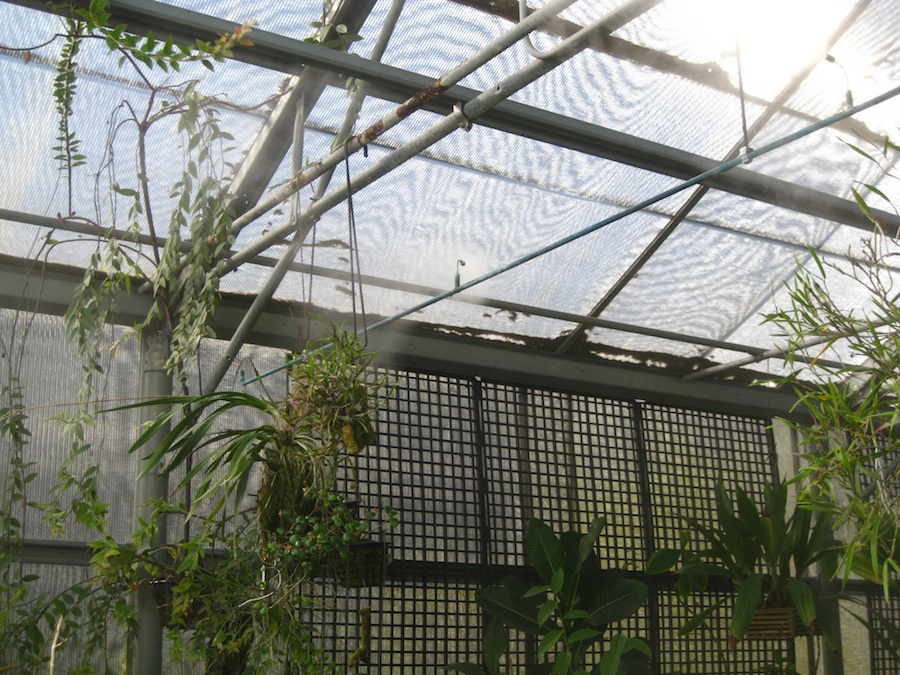
Some of the hanging plans we in line with the misters so they really got wet
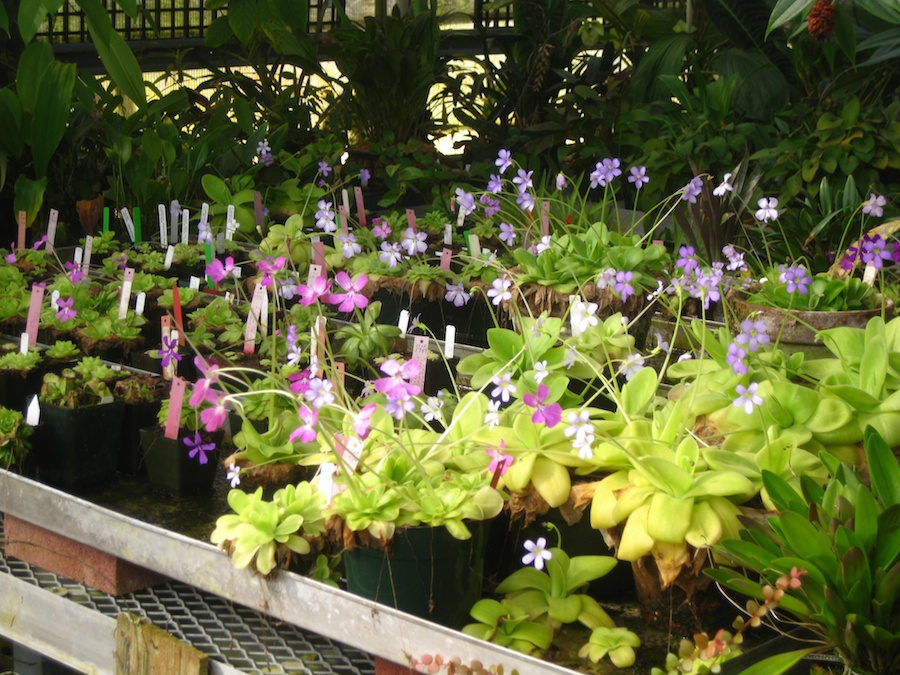
The tags are essential... He said "You can touch the plants but
please do NOT touch the tags"
Did You Know? - A plant is important to a botanist only if they know all about it... Where it is from exactly, time and date gathered, what it was near... etc. etc.

Taking in all the new found knowledge
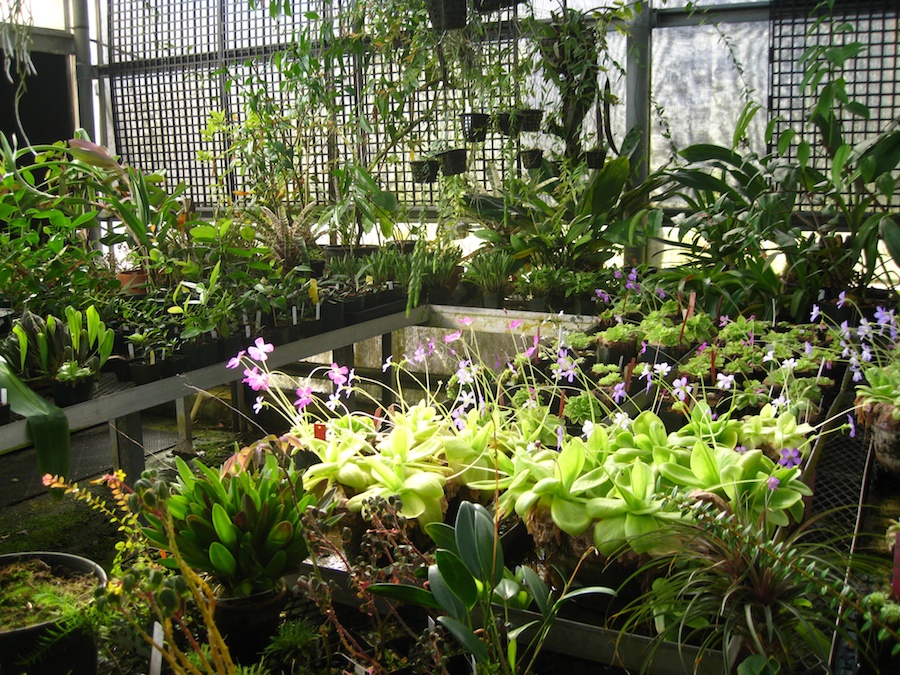
Great place to work on plants.... Waist high and no bending over

The fans came on and off at their own rate...
Probably having something to do with temperature

It was a large hot house... Our group was fifteen and
we were pretty small compared to the hothouse

This one looked like an elephant... See his ears and trunk???

Amazing colors

Why? Will we ever know??
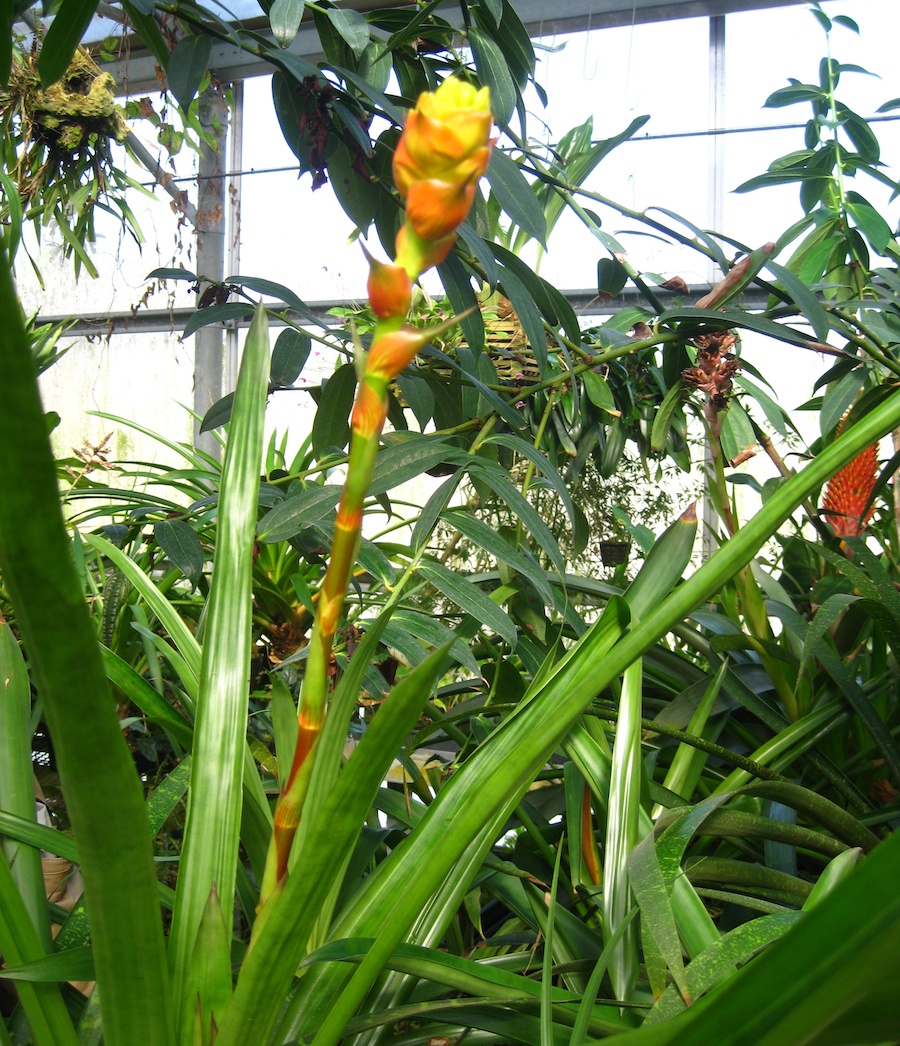
Looks like a torch

We had an idea but after all, it was Greg's birthday

The plastic was called "Convectube" and is used to send heat throughout
the hot house! It expands when the fan and heaters are energized.
Much less expensive than hard ducts plus it is transparent!

"Hello there human"

Where the heater/fan connects to the convectube. They never want to
have the plans get under 60 degrees or they get damaged

Outside for a moment before going to the second and less warm hothouse

The green trunk is from the "Stinky Plant"
or "Corpse Plant"
Did You Know? - Amorphophallus titanum (from Ancient Greek amorphos, "without form, misshapen" + phallos, "phallus", and titan, "giant" ), known as the titan arum, is a flowering plant with the largest unbranched inflorescence in the world. The titan arum's inflorescence is not as large as that of the talipot palm, Corypha umbraculifera, but the inflorescence of the talipot palm is branched rather than unbranched.
Due to its odor, which is reminiscent of the smell of a decomposing mammal, the titan arum is characterized as a carrion flower, and is also known as the corpse flower, or corpse plant (Indonesian: bunga bangkai ? bunga means flower, while bangkai can be translated as corpse, cadaver, or carrion).
For the same reason, the title corpse flower is also attributed to the genus Rafflesia which, like the titan arum, grows in the rainforests of Sumatra.
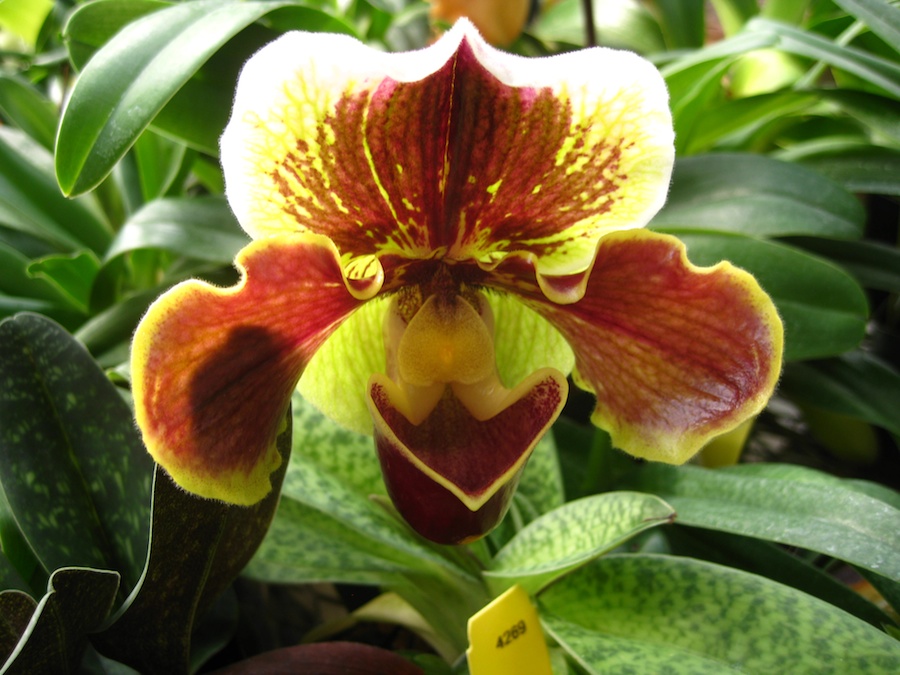
The orchids were simply magnificent
Did You Know? - Orchidaceae is a diverse and widespread family of flowering plants with blooms that are often colourful and often fragrant, commonly known as the orchid family. Along with the Asteraceae, they are one of the two largest families of flowering plants, with between 21,950 and 26,049 currently accepted species, found in 880 genera.
Selecting which of the two families is larger is still under debate, as concrete numbers on such enormous families are constantly in flux. Regardless, the number of orchid species equals more than twice the number of bird species, and about four times the number of mammal species. The family also encompasses about 6?11% of all seed plants.
The largest genera are Bulbophyllum (2,000 species), Epidendrum (1,500 species), Dendrobium (1,400 species) and Pleurothallis (1,000 species).

Very intricate designs

Greg and Paul attempted to communicate golors to Irene and Sue

They look so delicate
...
Lemon or Banana or Yellow????

The colors are dramatic...

Looks like he is trying to talk to us

Snowy white... But why the yellow
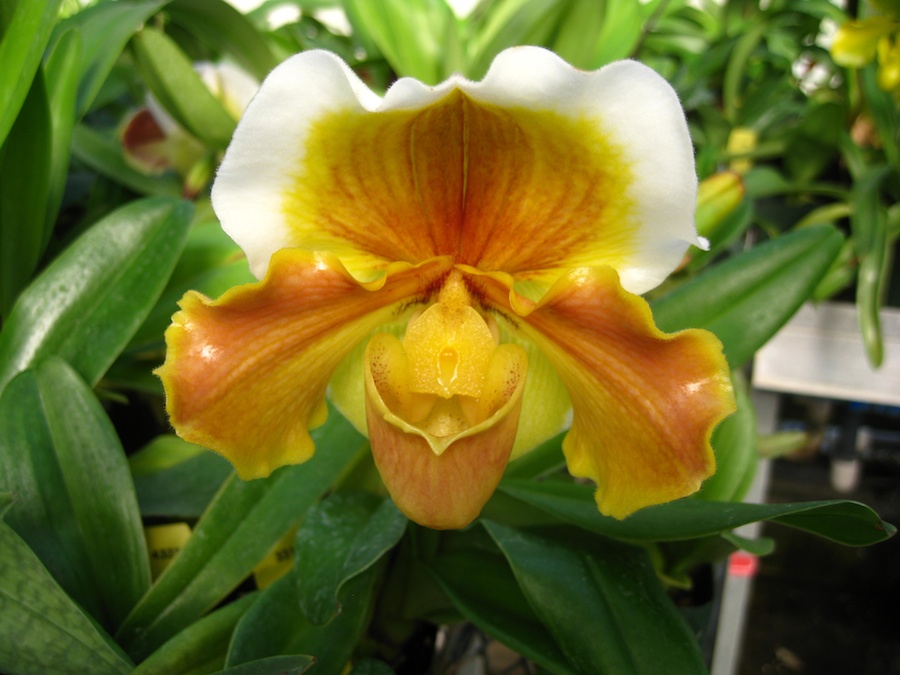
Felt like putting a coin in the cup...

It almost looks like a silk plant

Outside again we pass by the cactus... These will be for sale in April

Irene declares victory

These filters keep the bugs out of the hot houses when the fans are turned on
Did You Know? - The idea of growing plants in environmentally controlled areas has existed since Roman times. The Roman emperor Tiberius ate a cucumber-like[6] vegetable daily. The Roman gardeners used artificial methods (similar to the greenhouse system) of growing to have it available for his table every day of the year.
Cucumbers were planted in wheeled carts which were put in the sun daily, then taken inside to keep them warm at night. The cucumbers were stored under frames or in cucumber houses glazed with either oiled cloth known as specularia or with sheets of selenite (a.k.a. lapis specularis), according to the description by Pliny the Elder.
In the 13th century, greenhouses were built in Italy to house the exotic plants that explorers brought back from the tropics. They were originally called giardini botanici (botanical gardens).
